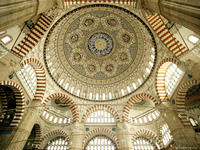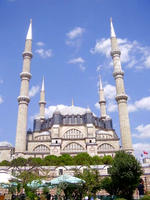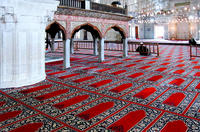You are in: Asia -> Turkey -> Selimiye Mosque and ... , and traditional search or Image Gallery will yield results of this site only
Selimiye Mosque and its Social Complex
| Site number: | 1366 |
|
| Type of site: | Cultural | |
| Date: | 1500 - 1599 | |
| Date of Inscription: | 2011 | |
| Location: | Eurasia, Turkey, Edirne | |
Up to 75 images are shown here. Click on each for more details or on Image Gallery for more images.
Six official UN languages:
Arabic,
Chinese,
English,
French,
Russian,
Spanish
Other languages: Albanian, Azərbaycanca, Bosnian, Bulgarian, Croatian, Dutch, German, Hungarian, Italian, Japanese, Macedonian, Polish, Portuguese, Serbian, Swedish, Thai, Turkish
Other languages: Albanian, Azərbaycanca, Bosnian, Bulgarian, Croatian, Dutch, German, Hungarian, Italian, Japanese, Macedonian, Polish, Portuguese, Serbian, Swedish, Thai, Turkish
| Description: | The square Mosque with its single great dome and four slender minarets, dominates the skyline of the former Ottoman capital of Edirne. Sinan, the most famous of Ottoman architects in the 16th century, considered the complex, which includes madrasas (Islamic schools), a covered market, clock house, outer courtyard and library, to be his best work. The interior decoration using Iznik tiles from the peak period of their production testifies to an art form that remains unsurpassed in this material. The complex is considered to be the most harmonious expression ever achieved of the Ottoman külliye, a group of buildings constructed around a mosque and managed as a single institution. --WHMNet's description is from WHC Site, where additional information is available. | |
| The Selimiye Mosque (Turkish: Selimiye Camii) is an Ottoman mosque in the city of Edirne, Turkey. The mosque was commissioned by Sultan Selim II and was built by architect Mimar Sinan between 1568 and 1574. It was considered by Sinan to be his masterpiece and is one of the highest achievements of Islamic architecture. This grand mosque stands at the center of a külliye (complex of a hospital, school, library and/or baths around a mosque) which comprises a medrese (Islamic academy teaches both Islamic and scientific lessons), a dar-ül hadis (Al-Hadith school), a timekeeper's room and an arasta (row of shops). In this mosque Sinan employed an octagonal supporting system that is created through eight pillars incised in a square shell of walls. The four semi domes at the corners of the square behind the arches that spring from the pillars, are intermediary sections between the huge encompassing dome (31.25m diameter with spherical profile) and the walls. --Wikipedia. Text is available under the Creative Commons Attribution-ShareAlike License. | ||
| Source: | http://whc.unesco.org/en/list/1366 | |
| Reference: | 1. UNESCO World Heritage Center (http://whc.unesco.org/en/list/1366). 2. Wikipedia. | |











